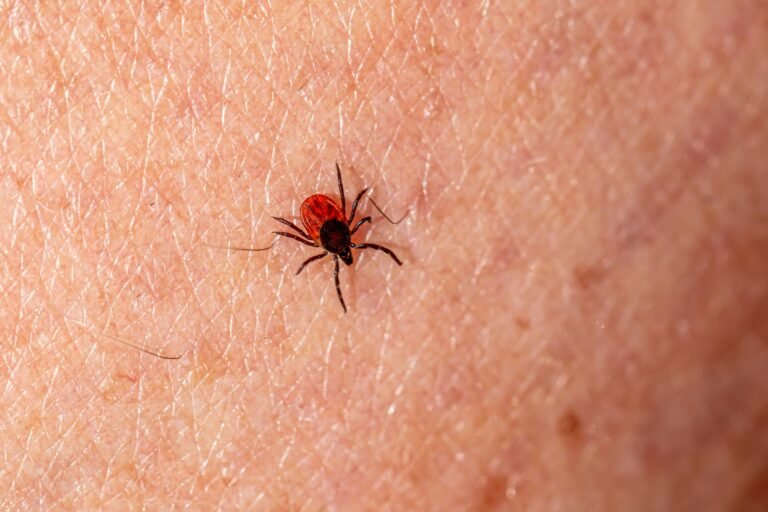Lyme Disease

What You Need to Know About the Tick-Borne Illness
Note: The following article is for educational purposes only and should not be used to diagnose or treat any diseases. If you think you may have Lyme Disease, consult a doctor or other medical professional.
Lyme disease is the most common vector-borne illness in the United States and Europe, transmitted to humans through the bite of infected black-legged ticks, commonly called deer ticks. While often associated with outdoor activities in wooded or grassy areas, Lyme disease can affect anyone, anywhere ticks thrive. Understanding the symptoms, risks, and prevention strategies can help reduce your chances of infection and ensure early treatment if you’re exposed.
What Is Lyme Disease?
Lyme disease is caused by the Borrelia burgdorferi bacterium, and less commonly by Borrelia mayonii. Once transmitted through a tick bite, the bacteria can spread through the bloodstream, leading to a wide range of symptoms affecting the skin, joints, heart, and nervous system.
How Is Lyme Disease Transmitted?
Ticks become infected when they feed on infected animals like mice or deer. A tick must typically be attached for 36 to 48 hours to transmit Lyme bacteria. Most infections occur in late spring and summer when ticks are most active and people are more likely to be outdoors.
High-risk regions include:
The Northeastern and upper Midwestern United States
Parts of Europe (especially Central and Eastern regions)
Areas with dense woodland, tall grass, or high deer populations
Early Symptoms of Lyme Disease
The first signs often appear 3 to 30 days after a tick bite. Early-stage symptoms can include:
Erythema migrans (EM): A red rash often resembling a bull’s-eye, expanding from the bite site
Fatigue
Fever and chills
Headache
Muscle and joint aches
Swollen lymph nodes
The EM rash appears in about 70-80% of infected individuals and may not be itchy or painful, making it easy to miss.
Later Symptoms and Complications
If left untreated, Lyme disease can progress and lead to more serious complications, including:
Severe joint pain or arthritis (especially in the knees)
Heart palpitations or Lyme carditis
Dizziness or shortness of breath
Inflammation of the brain and spinal cord
Nerve pain or facial palsy (loss of muscle tone on one or both sides of the face)
Cognitive issues like memory problems or difficulty concentrating (sometimes referred to as “Lyme brain”)
Diagnosis and Testing
Lyme disease is primarily diagnosed based on clinical symptoms and a history of possible tick exposure. Blood tests such as ELISA and Western blot can detect antibodies, but these may not be reliable in the first few weeks of infection. If you suspect Lyme disease, especially after seeing a bull’s-eye rash or following a known tick bite, consult a healthcare provider promptly.
Treatment and Recovery
The standard treatment for Lyme disease is a course of oral antibiotics, typically doxycycline, amoxicillin, or cefuroxime axetil, for 10 to 21 days. Most patients recover completely with early treatment. In cases of advanced or persistent symptoms, longer or intravenous antibiotic therapy may be necessary. Some individuals experience Post-Treatment Lyme Disease Syndrome (PTLDS), where fatigue and joint pain linger even after treatment. The cause of PTLDS is still being researched.
Prevention Tips
Preventing tick bites is the best way to avoid Lyme disease:
Use insect repellent with at least 20% DEET on exposed skin
Wear long sleeves and pants when hiking or walking through grassy areas
Tuck pants into socks and stick to trails when possible
Check your body and clothing for ticks after spending time outdoors
Shower within two hours of being outdoors to wash away unattached ticks
Remove ticks properly using tweezers—grasp close to the skin and pull steadily upward
Additionally, consider treating pets and outdoor gear with tick-prevention products.
Lyme disease can be serious, but early detection and proper treatment can lead to a full recovery. Staying informed, practicing prevention, and knowing the symptoms can go a long way in protecting yourself and your family during tick season. If you believe you’ve been bitten by a tick or are experiencing symptoms, don’t delay—consult your healthcare provider and monitor your health closely.
Sources: